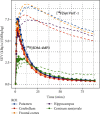First-in-Human PET Imaging of [18F]SDM-4MP3: A Cautionary Tale
- PMID: 37719326
- PMCID: PMC10504053
- DOI: 10.1155/2023/8826977
First-in-Human PET Imaging of [18F]SDM-4MP3: A Cautionary Tale
Abstract
[18F]SynVesT-1 is a PET radiopharmaceutical that binds to the synaptic vesicle protein 2A (SV2A) and serves as a biomarker of synaptic density with widespread clinical research applications in psychiatry and neurodegeneration. The initial goal of this study was to concurrently conduct PET imaging studies with [18F]SynVesT-1 at our laboratories. However, the data in the first two human PET studies had anomalous biodistribution despite the injected product meeting all specifications during the prerelease quality control protocols. Further investigation, including imaging in rats as well as proton and carbon 2D-NMR spectroscopic studies, led to the discovery that a derivative of the precursor had been received from the manufacturer. Hence, we report our investigation and the first-in-human study of [18F]SDM-4MP3, a structural variant of [18F]SynVesT-1, which does not have the requisite characteristics as a PET radiopharmaceutical for imaging SV2A in the central nervous system.
Copyright © 2023 Kimberly L. Desmond et al.
Conflict of interest statement
A.P.S. is a consultant for Hoffman La Roche and received honoraria from GE Health Care Canada Ltd. and Hoffman La Roche.
Figures








References
Publication types
MeSH terms
Substances
Grants and funding
LinkOut - more resources
Full Text Sources
